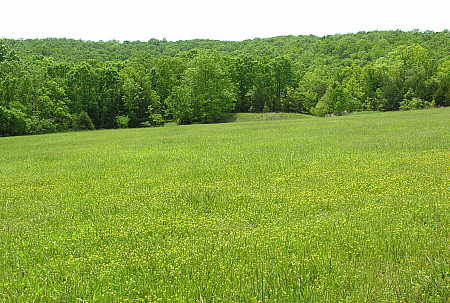 Â
Â
We have several ponds here at the ranch, each with it’s own character, and each with it’s own set of problems and pleasures. This post is about our small catfish pond, which is located in a margin between grassland and woods. In the picture above you can see the berm which creates one bank of the pond, at the far end of this field.
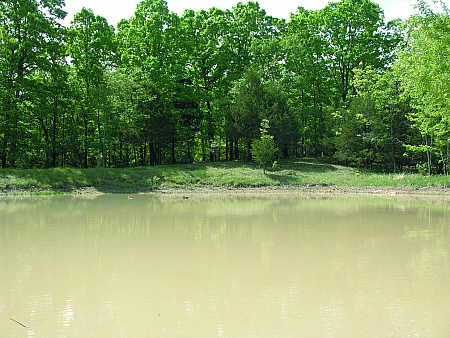
This is what the pond looks like, viewed from the berm which was constructed to contain the pond water. Across the pond, in the woods, is an area I cleared of brush and set up a fire ring and glider. It has become an area where Retta and I like to sit and contemplate the world around us, and sometimes have a picnic. This is what the area looks like –
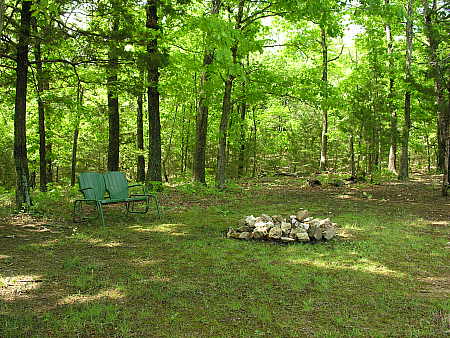
When seated at the picnic area, the view looks across the field towards our barns and paddock facilities.  It is a lovely spot, and I always like to sit here to take a little break during my work day, surveying my little domain and enjoying the peace and quiet (country quiet, which is sometimes not all that quiet, but I digress).
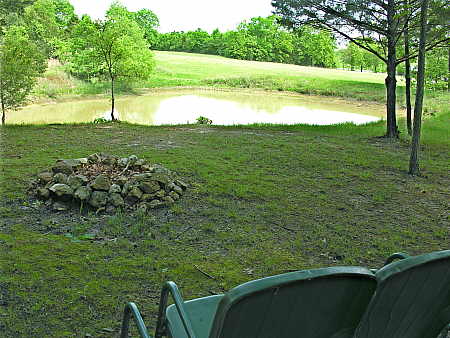
As you can plainly see from the pictures, this is not a clear pond. It is designed to catch the runoff from a clay based gully which drains about a forty acre watershed. Every time it rains, clay is washed into the pond along with the rain water.  From the time we first acquired this property, I have been dissatisfied with the lack of water clarity in this pond. I mentioned this problem to an employee of the local farm store, and he told me he had just the solution. He sold me a gallon container of a liquid, which I proceeded to apply to the pond per the directions. I should have done more homework than I had, because this is what I ended up with –
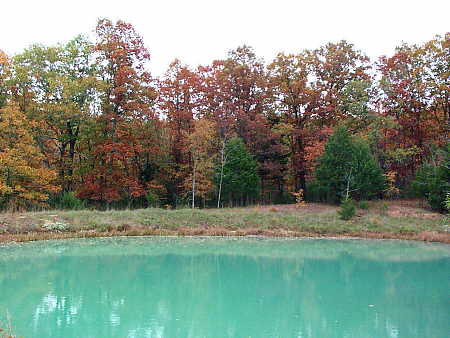
Now, I don’t know about you, but I prefer the natural silty brown over this obviously artificial looking turquoise dyed pond. Fortunately, the pond returned to it’s former natural state after a few rains. Unfortunately, the pond was bright turquoise when NASA flew over us on their latest photography mission. In the space imagery that was produced from this mission, our pond color stands out like a beacon in the night. I even received a comment about this from the Arkansas Forestry Commission forester who came out to assess our property. He said he had to stop and scratch his head a few times trying to figure out what that bright turquoise spot was on the image!
I have since been told that there is some kind of chemical product that can be added to the water that affects the ionization of the suspended particulate matter, causing it to sink to the bottom of the pond. I have not been able to locate any such product, except for certain solutions meant to be used in tiny backyard ponds. And if I can find this product, I suppose that it would have to be used whenever the rains washed more clay silt into the pond. So I will instead try to accept the pond as it is. After all, there are plenty of healthy catfish and minnows living in it, so why should I care? And most important, guests who come to visit us here at the ranch always seem to enjoy throwing in a line, even if the water is silty.
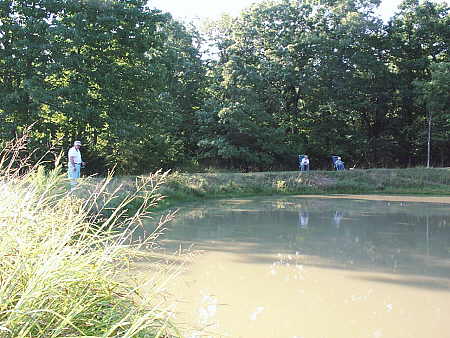



Hal, the product you’re describing is generically called flocculant; it can be purchased in many online garden and pond stores. We use it occasionally in our koi pond when suspended algae gets a little heavy, or after I’ve done a lot of plant and pond work. It is relatively inexpensive, and works wonderfully (unlike most of the other products sold for ponds). It clears a pond up within a day depending upon water movement. It has proven safe for fish and plants. Search google for “pond flocculant”; it will be found under many brand names.
Flocculant is often used to clear drinking water and is, from memory, aluminium sulphate [English Spelling]. Some worry that the aluminum [US Spelling] might contribute to Alzheimer’s.
But I forget why…
There’s some info here
http://en.wikipedia.org/wiki/Flocculant
And then there is this joke
“Doc, you said you wanted to see me.
Yep. I’ve got two bits of bad news.
Sock it to me, Doc.
Well, first, you’ve got AIDS.
Geez, isn’t that deadly.
‘Fraid so.
What else have I got.
Alzheimer’s.
Ah, that’s not so bad…I could have had AIDS.”
Have you thought about building a silt pond a little up the watershed from this catfish pond? All of the clay silt could accumulate and precipitate in the silt pond, and only clear but fish-loving top water from it would then make its way down to the catfish pond. I talked to my builder about that, but a) I don’t have much silt to worry about and b) he said i would stir up more silt building the pond that I would catch with it.
A pond at an office park where I worked would regularly turn blue each season. I suppose this chemical treatment was the reason.
That’s one thing we didn’t get with our recent purchase, a pond. After having those post holes dug into solid rock, I’m not sure I want to tackle making a pond!
Yours looks great to me, silt and all.
Thank you all for your help with my silty pond. With your guidance, here is what I found.
The type of flocculant that would best be suited for this use would be alum (aluminum sulphate), sold commercially in 50# sacks for $40.00 locally, or $.80/pound. The amount required depends on the volume of water in the pond, so here is a quick analysis.
The pond is circular, with a diameter of 200 feet. It is 6 feet deep in the center, so I will use 3 feet as the average depth. By using the formula to calculate the volume of a cylinder, we find that the pond holds 94,200 cubic feet of water, which equates to 704,616 gallons of water.
It is difficult to determine an accurate dosage rate, and I have found recommendations ranging from 4-12 pounds per 10,000 gallons. Assuming the minimum dosage rate of 4 pounds per 10,000 gallons is correct, then a single treatment of the pond would require 281 pounds of alum per treatment, at a cost of $225. This $225 treatment would need to be repeated as frequently as the rains dictate, which would get very expensive, very quick.
Additionally, alum is toxic to aquatic life if the water chemistry is not correct PRIOR to its use. Overall hardness, calcium hardness and pH all must be within the correct bounds for alum to be safe to the fish, which in itself would require the addition of other chemicals to achieve the proper balance.
One more factor that Tjilpi brought up is the possible Alzheimer’s connection with aluminum and aluminum compounds, which is a very sensitive subject for me personally. For many, many years my family had been involved in the manufacture of aluminum outdoor furniture. It is very likely that if you are reading this (even you Tjilpi, when you were in the US) you have sat in one of the chairs that we produced at one time or another. Tragically, one Uncle passed away several years ago after suffering the effects of Alzheimer’s. Another Uncle is currently suffering this scourge of a disease, and it is a heartbreaking experience to witness. I take the possible connection of Alzheimer’s and aluminum very seriously, and become distressed from time to time when I experience the fleeting incidents of memory loss that all of us sometimes experience. This is a long way of saying that I think I’ll pass on the flocculant option.
Pablo, your idea is a grand one, but it wouldn’t work due to the particular lay of the land above the pond. The watershed that it catches is quite steep immediately behind the pond, and there is no place to put a silt revetment. What would work, however, would be to consider this pond the silt collection pond, and dig another one just downstream from this one. This is an option that I might seriously consider in the future, as funding and priority considerations warrant.
Thanks again all, for your help. Now I know what I’m up against.
Duane, thanks for the encouraging words. I will end up learning to love this pond, despite it’s siltiness.
Don’t be afraid to build your own pond on account of the Ozarks rocky terrain. After all, a bulldozer, rock hammer and a little dynamite goes a long way in creating a big hole quickly. And getting it to hold water builds character (just ask Pablo) 😉
I’m all for the dynamite…
Sometme I’ll find a way of showing you the Xray of my left hand – with shrapnel still extant.
Red phosphourus and Potassiam Chlorate sure makes a bang.
My brother thought I had fired a .303 in his right ear.
I was lucky not to lose my left eye.
I had my first pair of “glasses” – real glass – fitted a month earlier. There was a chip taken out where my left cornea lies.
Take care with those dodgy diesel fillers…
And on the Al connection:
I appreciate, but don’t have an informed medical opinion, on the subject.
It seems to me to be a parachute – hanging mid-air on an indeterminate thermal.
But, hey, don’t let it cause yourself grief. None of us know the answers to many things that are up close and personal.
I cook in Al pans all the time.
Duane, you shoud give a go at getting yourself a pond. Contact the local USDA office and have them send a professional out to look at your land. He/she can make recommendations about where to site the pond/lake and how big you could expect it to be. I had a man come out to my woods to do this (after the fact of building the dam) and he thought there was hope for my leaky lake. But I think these guys are trained to be conservative – to point out the worst but hope for the best. So if you get one, don’t be too discouraged by what he/she says.
I agree with you Hal, that would be far too much additive, expense, and risk for a pond without filtration, frequent water changes and proper chemistry. Such ponds (especially those that become clay lined!) become toxic concentrators, as we all know impurities, hard metals and salts accumulate.
I have a love/hate relationship with your blog. I love reading the entries, I love reading about your life and the farm and the animals and everything else, but I HATE that it reminds me that I live in a one bedroom apartment in a fairly large city when I’d much prefer to live at least on 2-10 acres somewhere with a cow pasture or horse paddock close by. I am not a city girl in the way I need to be one to be happy here, and your blog, wonderful though it is, reminds me of that. *sigh*
Don’t quit writing, though!!!! I like torturing myself – honest!
Have you thought about the hay bale method?
http://ohiodnr.com/wildlife/Fishing/pond/muddy.htm
FC – I have researched the use of hay bales to clarify the colloidal clay in the pond, but have chosen not to utilize this method for the following reason. All authoritative sources that I have found caution strongly against using hay as a clarifier during the warmest months of the year, to avoid fish kills resulting from the decomposition of the hay in the pond water. But it is during the warmest months of the year that I would like the pond water to be clear, as we rarely recreate around the pond in the winter.
http://ohioline.osu.edu/a-fact/0006.html
From the above source:
“There is one important reason to use as little hay as necessary. The addition of large amounts of organic material, such as hay, can lead to oxygen depletion as the material decomposes. This is especially true in July and August. If hay application must occur in summer, supplemental aeration may be needed to prevent a fish kill.”
Your suggestion has led me to sources which indicate that gypsum may be a possible solution to my problem, so I am now investigating that possibility. Thanks for your help with this problem (?) of mine, and hopefully the muddy waters will clear soon.
10-4. That makes sense.
From a guy with a very clear pond, there is this solace…clear water = major submerged plant problem as light penetrates deeply. My fish are asking for a lawn mower!
I have a permit for grass carp, but the drought has me waiting for more water in the pond before I add anymore fish.
Pingback: Ranch Ramblins » Blog Archive » Oh My! Where Did It Go?
Pingback: Ranch Ramblins » Blog Archive » The People Pond
we recently finished building and stocking a pond in the front of our home just for our enjoyment. We placed 1000 catfish,700 hybrid bream in the pond, which covers approximately 1 1/2 acres. We are having a ball watching them feed. I need someone to help me by telling me how much to feed them. We go down to the pond late each day and feed them 2 1/2 gallons of floating feed.
They are growing beautifully, but I just want to make sure that we are feeding them enough. Anyone who knows, please respond. Thanks, Janice Loftin Columbia, MS 39429
Pingback: Ranch Ramblins » Blog Archive » A Benchtable
Pingback: Ranch Ramblins » Blog Archive » Visitors
I agree with you Hal, that would be far too much additive, expense, and risk for a pond without filtration
I have a 6000 sq.ft. silt pond before a 15 acer lake. Some of the pepole around the lake want it taken out. Were can I find some information to help them understand the inportance of the silt pond. We had a lot of silt in the lake before I added the silt pond but they did not live there at that time. Any help will be appreciated.
Thanks D. Marak
Rutherfordton NC.
I don’t have a website but I found this one today and thought it might interest you. They sell windmills that aerate your pond. It cuts down on weeds and silt and creates a healthy environment for your fish. No chemicals necessary.Hope this helps!
Hi everybody
2 years ago I dug a 9ft deep 90x90ft quarter acre pond with no inflow but water sumped from a nearby shallow well. And managed to keep it fairly full. I had to line it with 1ft of peanutbutter clay, and sure enough it stayed milky murky for a year. Any dstrurbance and whoosh it turned milky.
So last winter I dumped 3 trucklopads of sand over the ice…and this spring it looks much less milky,but still murky.
I figured I could use 4 gals of pond clear flocculant to clear it up more.
But the consensus here seems rather not….what gives?
I’d like it to be somewhat more swimminviting. visibility is max 1ft, 6 in more like it….
Fred
I have a wonderful pond I had dug in the woods, 40 X 40 foot and 8 foot deep. But we are in a drought and the pond had shrunk to tiny, and four foot down. So I jetted in a well – it is a big job, 40 foot deep, doing the work myself. $150 for pipe, 4150 for a pump).
And then ran the well water with my fountain to oxygenate the well water. By morning the pond was up a foot but had turned muddy red. the well water is full of clear iron which turns to tiny rust particles when it gets oxygen. Now it has water but is a mess. Systems to remove the iron from the water are very expensive so I thought I would try the flocculant method.
Fred, try the flocculant and get back to me. Also Hal, the company that makes the pond flocculant also makes blue pond dry – I wonder if you got that by mistake?
kris,
i am expecting a crew to “jet out” my 12ft deep shallow well nearby….i hope down to 25 feet!
that should be sufficient for a 1-2gpm sprinkler year round, in the middle, to maintain level, aerate and keep algae off.
i used an immersed aerator and all that it did was make more milky turbidity. wont try that again!
but then if the problem persists ill try flocculants, damn the alum scare.
fred